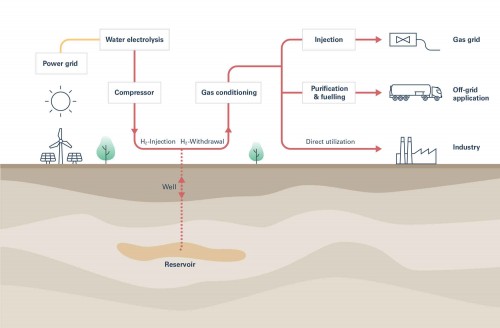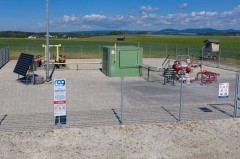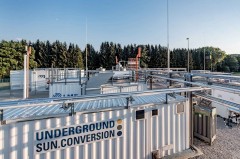Long-term storage of renewable energy sources will play a central role in the future energy system. Underground gas storage facilities are long-established large-volume energy storage facilities with high storage capacities. By converting electrical energy into hydrogen, the existing natural gas infrastructure – consisting of pipelines and natural gas storage facilities – could be used as buffer storage for surplus energy from renewable sources. This pioneering concept for energy storage will be further researched and tested in practice over the next few years in the Austrian flagship project “Underground Sun Storage 2030”. Under the leadership of RAG Austria AG, safe, seasonal and large-volume storage of renewable energy sources in the form of hydrogen in underground gas storage facilities will be developed by 2025 in cooperation with numerous corporate and research partners1. The aim is also to gain valuable technical and economic knowledge for the development of a secure hydrogen supply in Austria.
Storing hydrogen underground
The hydrogen compatibility of underground pore storage systems had already been investigated in the previous projects “Underground SUN.STORAGE” and “Underground.SUN.Conversion”. It was possible to prove that a hydrogen content of up to 20% can be stored in natural-gas storage facilities with good levels of compatibility. A new process was researched within the framework of “Underground.SUN.Conversion” to produce renewable natural gas directly in a gas storage facility through a microbiological process that was initiated specifically. For this purpose, hydrogen produced from wind and solar energy is pumped with CO2 (e.g. from biomass combustion) into an existing gas storage facility over 1,000 metres below ground. A methanation process subsequently takes place naturally in the underground rock layers, i.e. hydrogen and CO2 are converted into methane in a relatively short time. The renewable natural gas can then be stored directly in the storage facility and withdrawn and used flexibly in accordance with requirements.
Interdisciplinary research and road tests
Further laboratory tests showed that a hydrogen content of up to 100% would also be possible in the underground storage facilities. Building on the previous projects and the findings to date, the “Underground Sun Storage 2030” project is now moving to real benchmarks and investigating the storage of pure hydrogen in underground gas storage facilities as part of a road test. Together, the project partners will carry out interdisciplinary technical-scientific investigations under real conditions at a small underground gas storage facility in the municipality of Gampern in Upper Austria. A customised research facility is being built for this purpose. The investigations are supplemented by the development of suitable processing technologies, the modelling of future energy scenarios and economic analyses. The partners also want to work on various other aspects related to stored hydrogen. These include:
> the use of hydrogen as a substitute for fossil natural gas
> the direct use of hydrogen in the energy-intensive industry
> the preparation and utilization of hydrogen with high purity

Key technology in the sustainable energy system
Storable gaseous energy carriers, such as hydrogen, have major potential in playing a central role in the future energy system. The conversion of surplus solar and wind power into large-volume and seasonally storable gaseous energy carriers is a key technology in implementing a secure energy supply based on renewable energy sources. The globally unique project “Underground Sun Storage 2030” will provide important insights into the seasonal storage of renewable energy sources in the form of hydrogen.
www.underground-sun-storage.at/en/project/project-description.html
www.underground-sun-conversion.at/en
www.uss-2030.at/en

„RAG’s strength lies in its strong innovative power and responsible forward-looking actions. What we do is always supported by a long-term perspective, with investments for generations. The main problem with renewable energy sources is their volatility and the fact that they are not available all year round. The necessary reduction of CO2 emissions in the energy systems will only succeed if part of the summer energy harvested from solar and wind can be carried over into the winter.“
Markus Mitteregger
CEO RAG Austria AG
1 Project Partners RAG Austria AG (project management), Axiom Angewandte Prozesstechnik GmbH, Energie AG, Energy Institute at the Johannes Kepler University Linz, EVN AG, HyCentha Research GmbH, K1-MET GmbH, TU Wien/Institute of Chemical, Environmental and Bioscience Engineering, University of Natural Resources and Applied Life Sciences/Interuniversity Department of Agricultural Biotechnology, IFA-Tulln, VERBUND, voestalpine Stahl GmbH
A project within the framework of the WIVA P&G – Austria Power & Gas Flagship Region hydrogen initiative
www.wiva.at


